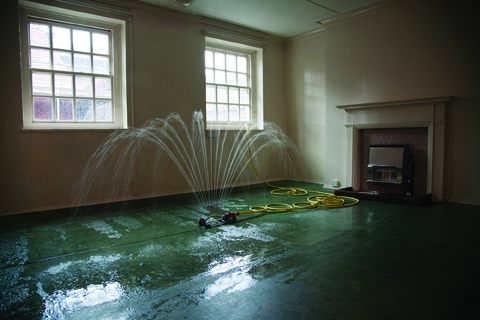Threats to humans and buildings alike coalesce in Abbas Akhavan’s five interventions into Delfina’s newly acquired shabby townhouse, before the gallery’s imminent renovation to enlarge the foundation’s current space next door.
A wall of Leylandii hedging, the traditional suburban privacy screen (and controversial seed of the UK’s 2005 High Hedges Act), stalls the visitor in the reception area, suggesting visitation beyond to be trespass. It’s a simple, beautifying winter-garden room divider, doubling as an enactment of the public/private threshold and nature’s militarisation as defence. In the room behind, an altered drop-leaf dining table, decked out with rags and a watering can (a found-materials assemblage with a hint of foreboding), channels dripping water into a rubber masonry tub. A rust-coloured stain on the ceiling above suggests this might be due to a leak. Why is the ceiling leaking? Maybe it’s due to this work’s correlative, an oscillating sprinkler violating a linoleum floor with a pool of water two floors up, as if a vicious gardener hell-bent on collapsing a ceiling rather than nurturing turf had performed a spot of domestic terrorism. But the two works’ dialogue is conceptual, not physical. A damp-free floor of the building separates them, but it too has not been spared our guerrilla gardener. Vines sprout from the room’s threadbare floral carpet, their scant trailing feeling more as though a florist has left in a hurry than a ruinous incursion of the natural world. In the basement, a lone dining table supports an ominous perfect cuboid of manure-rich earth, like a green-fingered minimalist’s open grave. It’s the show’s weakest link, giving the former dining room an air of morgue-cum-torture-chamber, lacking the subtler dialogue with site the stronger works enact.
Akhavan’s interest in, as he puts it, “how sculpture can have territorial behaviour”, and in the domestic as a site of latent violence, is invested in these ephemeral pieces which use canny DIY to disguise their technical ingenuity. The leak is a trompe l’oeil; the artist has rather created a slowly dribbling fountain in emulation of a water-boarding chamber (information ‘leaked’ by the artist in conversation, but concealed in the show’s official framing). The sprinkler-lake bluffs its destructive desire by recycling its water from an unseen trough beneath the floorboards, mystifying the audience via the visual diversion of a hosepipe through the window. But this clever trickery, and the illusory ‘as found’ appearance of the works, render the artist’s loaded intentions less visible among the building’s polyphony of voices; those of its former (pensionable) office workers, and its current residents (whose presence is attested to by toothbrushes in bathrooms and Alpen in the kitchen, as the visitor stumbles about in search of the art). A visit is like stepping into a nascent and eerily empty Occupy squat, whose members are up for a bit of ruination-pre-renovation. But perhaps this is apt, given the artist’s keenness to present the political dimension of ‘residency’.
Akhavan elegantly repurposes domestic items and gardener’s tools as metaphorical tools of torture (both of humans and the home itself), but maybe the building gets its own back on these sculptures, by quieting their protestation and cloaking their magic.
This article was first published in the January & February 2013 issue.
